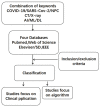A Promising and Challenging Approach: Radiologists' Perspective on Deep Learning and Artificial Intelligence for Fighting COVID-19
- PMID: 34679622
- PMCID: PMC8534829
- DOI: 10.3390/diagnostics11101924
A Promising and Challenging Approach: Radiologists' Perspective on Deep Learning and Artificial Intelligence for Fighting COVID-19
Abstract
Chest X-rays (CXR) and computed tomography (CT) are the main medical imaging modalities used against the increased worldwide spread of the 2019 coronavirus disease (COVID-19) epidemic. Machine learning (ML) and artificial intelligence (AI) technology, based on medical imaging fully extracting and utilizing the hidden information in massive medical imaging data, have been used in COVID-19 research of disease diagnosis and classification, treatment decision-making, efficacy evaluation, and prognosis prediction. This review article describes the extensive research of medical image-based ML and AI methods in preventing and controlling COVID-19, and summarizes their characteristics, differences, and significance in terms of application direction, image collection, and algorithm improvement, from the perspective of radiologists. The limitations and challenges faced by these systems and technologies, such as generalization and robustness, are discussed to indicate future research directions.
Keywords: COVID-19; artificial intelligence; deep learning; machine learning; medical imaging.
Conflict of interest statement
The authors declare no conflict of interest.
Figures
Similar articles
-
Artificial intelligence (AI) for medical imaging to combat coronavirus disease (COVID-19): a detailed review with direction for future research.Artif Intell Rev. 2022;55(2):1409-1439. doi: 10.1007/s10462-021-09985-z. Epub 2021 Apr 15. Artif Intell Rev. 2022. PMID: 33875900 Free PMC article.
-
A Systematic Review on the Use of AI and ML for Fighting the COVID-19 Pandemic.IEEE Trans Artif Intell. 2021 Mar 1;1(3):258-270. doi: 10.1109/TAI.2021.3062771. eCollection 2020 Dec. IEEE Trans Artif Intell. 2021. PMID: 35784006 Free PMC article.
-
Automatic COVID-19 detection mechanisms and approaches from medical images: a systematic review.Multimed Tools Appl. 2022;81(20):28779-28798. doi: 10.1007/s11042-022-12952-7. Epub 2022 Mar 31. Multimed Tools Appl. 2022. PMID: 35382107 Free PMC article.
-
Artificial Intelligence and COVID-19 Using Chest CT Scan and Chest X-ray Images: Machine Learning and Deep Learning Approaches for Diagnosis and Treatment.J Pers Med. 2021 Sep 30;11(10):993. doi: 10.3390/jpm11100993. J Pers Med. 2021. PMID: 34683133 Free PMC article. Review.
-
Is Artificial Intelligence the New Friend for Radiologists? A Review Article.Cureus. 2020 Oct 24;12(10):e11137. doi: 10.7759/cureus.11137. Cureus. 2020. PMID: 33240726 Free PMC article. Review.
Cited by
-
Machine Learning Consensus Clustering Approach for Hospitalized Patients with Dysmagnesemia.Diagnostics (Basel). 2021 Nov 15;11(11):2119. doi: 10.3390/diagnostics11112119. Diagnostics (Basel). 2021. PMID: 34829467 Free PMC article.
-
Application of artificial intelligence in diagnosing COVID-19 disease symptoms on chest X-rays: A systematic review.Int J Med Sci. 2022 Sep 28;19(12):1743-1752. doi: 10.7150/ijms.76515. eCollection 2022. Int J Med Sci. 2022. PMID: 36313227 Free PMC article.
References
Publication types
LinkOut - more resources
Full Text Sources




